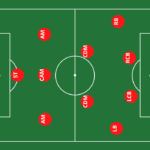Mastering Soccer Jargon: A Glossary for Fans and Players
Whether you’re a fan cheering from the sidelines or a player sprinting across the pitch, understanding soccer jargon is key to fully immersing yourself in the game.
From football terminology to soccer slang, this comprehensive guide will equip you with the vocabulary you need to speak the language of soccer with confidence.
As you delve into the world of soccer, you’ll encounter a wide range of terms, expressions, and phrases that are unique to the sport. From basic soccer vocabulary to advanced concepts, we’ll cover it all, ensuring you’re well-versed in soccer lingo.
So, whether you’re new to the game or a seasoned enthusiast, join us as we explore the rich tapestry of soccer jargon and unlock the secrets to fluent soccer-speak!

Key Takeaways:
- Understanding soccer jargon is crucial for both fans and players to fully engage with the sport.
- Familiarize yourself with football terminology, soccer slang, and expressions to enhance your soccer conversations.
- Mastering soccer vocabulary allows you to appreciate the nuances of the game and its strategic elements.
- By immersing yourself in soccer jargon, you’ll cultivate a deeper connection to the sport and its passionate community.
- Stay tuned as we guide you through the different sections of our comprehensive glossary, covering everything from field terminology to scoring techniques and professional soccer talk.
Understanding the Field: Terminology from Sidelines to Goal Lines
In the game of soccer, the field is not just a mere playing surface. It is a carefully designed space with specific features, each serving a unique purpose. To truly grasp the dynamics of the game, it’s essential to understand the terminology associated with different elements of the soccer field.
Let’s start with the basics: the soccer field, also known as a soccer pitch. This is the rectangular area where all the action takes place. It consists of various components that play a significant role in defining the gameplay.
At the very heart of the field lies the center spot. This is the spot where the game begins, with the kickoff. From here, both teams aim to gain control of the ball and advance towards their opponents’ goal.
The goal lines are located at the ends of the field. As the name suggests, these lines mark the boundaries of the goal area.
They determine whether a goal has been scored or not when the ball crosses over them, either on the ground or in the air.
Running parallel to the goal lines are the sidelines. These are the shortest boundaries of the field, marking the area within which the game is played. The sidelines also serve as reference points for players, coaches, and officials during the game.
In each corner of the field, you’ll find the corner (corner kick) area. This is where corner kicks are taken, granting the attacking team an opportunity to play the ball into the penalty area and create scoring chances.
Speaking of the penalty area, it’s a crucial part of the field located in front of each goal. Also known as the 18-yard box, it extends 18 yards from the goal line into the field.
Inside the penalty area, specific rules and penalties come into play, such as fouls that result in penalty kicks.
Within the penalty area, there’s a designated spot called the penalty spot. This is where penalty kicks are taken following a foul within the box, placing the attacking player in a prime position to score.
Lastly, we have the 6-yard box, which is a smaller rectangular area located within the penalty area. This zone provides additional space around the goal, often used during set-pieces like goal kicks and corner kicks.
Understanding the terminology related to the different parts of the field is essential in comprehending the strategic gameplay, player positions, and rules of soccer.
Now that you have a grasp of the field’s key elements, let’s move on to discussing player positions and their roles in Section 3.

Player Positions and Roles: Decoding Soccer Vocabulary
Understanding the different player positions and roles is essential for deciphering soccer vocabulary. On the field, each position has specific responsibilities and contributes to the overall strategy of the team. Let’s take a closer look at the key positions in soccer:
Defenders
Defenders are responsible for protecting the team’s goal and preventing the opposition from scoring. They play a crucial role in maintaining the team’s defensive shape and often engage in tackling, blocking shots, and intercepting passes.
Midfielders
Midfielders are the engine room of the team, linking defense and attack. They provide support to both the defensive and forward lines, often covering large areas of the field. Midfielders are involved in ball distribution, maintaining possession, and creating scoring opportunities.
Forwards
Forwards are primarily responsible for scoring goals. They typically operate closer to the opposition’s goal, using their speed, agility, and technical skills to penetrate the defense and find scoring opportunities. Forwards provide a constant threat to the opposing team’s goalkeeper.
Goalkeepers
Goalkeepers are the last line of defense, protecting the team’s goal and making crucial saves. They need excellent reflexes, positioning, and communication skills. Goalkeepers play a vital role in organizing the defense and initiating counterattacks.
In addition to these specific positions, the starting 11 refers to the team’s lineup at the beginning of the match. The composition of the starting 11 can vary depending on the team’s tactics and the opponent’s strengths and weaknesses.
Understanding these player positions and roles will not only help you appreciate the game better but also enable you to communicate effectively about soccer.
So, the next time you’re watching a match or discussing soccer with friends, you can confidently analyze the game and discuss the performances of defenders, midfielders, forwards, goalkeepers, and the starting 11.

The Language of Scoring: From Assists to Volleys
Scoring goals is the ultimate goal in soccer, and understanding the language used to describe different aspects of scoring is essential for any fan or player. In this section, we will explore the vocabulary of scoring, including terms like assists, headers, shots, and volleys, allowing you to discuss goals with precision.
One crucial element of scoring a goal is the assist, which refers to the pass or play that directly leads to a goal. Assists showcase the teamwork and creativity of players, highlighting their ability to create scoring opportunities for their teammates.
When it comes to scoring goals, there are various techniques that players utilize. A header is a goal scored by striking the ball with the head. It requires precise timing, coordination, and often an aerial challenge with opponents. On the other hand, a shot is a goal attempt taken with the feet.
Shots can be taken from various positions on the field and require accuracy, power, and finesse. Finally, a volley is a goal scored by striking the ball in mid-air, typically after it has been delivered by a teammate or cleared by an opponent.
Volleys are often spectacular and require exceptional ball control and technique.
Understanding the language of scoring will deepen your appreciation for the artistry and skill demonstrated by goal scorers. It will also enable you to analyze and discuss goals in a more nuanced manner.
Whether it’s appreciating a perfectly timed header, marveling at a powerful shot, or being in awe of a well-executed volley, being familiar with these terms allows you to fully immerse yourself in the excitement of the game.
Soccer Jargon
Soccer is a sport rich in language, from technical terms to strategic talk and creative expressions. In this section, we will dive into the fascinating world of soccer jargon, exploring the different aspects that make the game so unique.
The Strategy Behind the Slang: Tactical Talk
One of the most intriguing aspects of soccer is the tactical talk used by coaches and players to communicate on the field. From discussing formations and positioning to planning set-piece strategies, understanding the language of soccer strategy is crucial for players and fans alike.
Whether it’s the high press, counter-attacking style, or possession-based play, tactical talk reveals the intricacies of the game and how teams approach different situations.
International Flavors of Soccer: Terms Across Borders
Soccer is a global game, played and loved in various countries and cultures. Each country brings its own unique soccer vocabulary, introducing an array of international terms to the sport.
From the Spanish “tiki-taka” style of play to the Brazilian “samba” flair, exploring international soccer terms allows us to appreciate the diversity of playing styles and the cultural influences that shape the game.
Creative Moves on the Pitch: Artistry Expressed in Jargon
Soccer is not only about tactics and strategy; it’s also a canvas for creative moves and artistry on the pitch. Players showcase their skills through dribbles, feints, and other imaginative maneuvers that leave spectators in awe.
The language of soccer artistry encompasses terms like “nutmeg,” “rabona,” and “panenka,” each representing a unique and visually stunning move that adds flair and excitement to the game.
The Rulebook Linguistics: Fouls, Offside, and Cards Explained
n order to fully understand and appreciate the game of soccer, it is essential to be familiar with the rules and regulations that govern it. The language used to describe these rules can sometimes be complex, but it is crucial for both players and fans to grasp the vocabulary associated with fouls, offside, and cards (yellow and red).
Let’s start by defining fouls. In soccer, a foul is an infringement of the rules committed by a player that results in a free kick or penalty kick for the opposing team.
These infractions can range from tripping or pushing an opponent to using excessive force or holding an opponent’s jersey. Understanding fouls allows players and fans to recognize when a violation has occurred and the subsequent consequences.
Next, let’s explore the concept of offside. Offside is called when an attacking player is nearer to the opponent’s goal line than both the ball and the second-to-last defender at the moment the ball is played to them.
This rule is in place to ensure fair play and prevent an attacking player from gaining an unfair advantage. Familiarity with the offside rule is crucial for players and fans to understand why certain actions are deemed offside and the impact it has on the game.
Finally, let’s discuss the use of cards in soccer. Yellow and red cards are issued by the referee to penalize players for misconduct. A yellow card is shown as a caution, typically for offenses such as unsporting behavior, persistent fouling, or time-wasting.
If a player receives two yellow cards in the same game, they are shown a red card and are sent off the field. A red card can also be shown directly for severe offenses, such as violent conduct or serious foul play. Understanding the implications of yellow and red cards helps players and fans comprehend the gravity of certain actions on the field.
By familiarizing yourself with the language of fouls, offside, and cards in soccer, you will gain a deeper understanding of the game and be able to follow the action more closely.
Whether you are a player striving for fair play or a fan cheering from the stands, knowing the rules and their linguistic nuances enhances your enjoyment and appreciation of the game.
Navigating Professional Soccer Talk: Leagues, Transfers, and Tournaments
Understanding Soccer Hierarchies: Promotion and Relegation
Professional soccer operates within a complex system of leagues, each with its own hierarchy and structure. Understanding the terms associated with promotion and relegation is crucial to comprehending the competitive nature of the sport.
In promotion and relegation, teams have the opportunity to move up or down between different tiers of the league system based on their performance. The goal is to climb the ladder and reach higher divisions, which offer greater prestige and competition.
At the end of each season, the teams that finish at the top of their division are promoted to a higher league for the following season. Conversely, the teams that finish at the bottom of their league are relegated to a lower division. This system creates excitement and keeps teams motivated throughout the season, as they strive to achieve promotion or avoid relegation.
Global Competitions: The Significance of the Champions League and World Cup
When it comes to soccer tournaments, few events hold as much prestige and allure as the UEFA Champions League and the FIFA World Cup.
The Champions League is an annual competition that brings together the top clubs from domestic leagues across Europe. The tournament showcases the best of the best, with teams vying for the coveted title of European champion.
The Champions League is known for its high-quality matches, fierce rivalries, and iconic moments that capture the imagination of soccer fans around the world.
On the international stage, the FIFA World Cup is the pinnacle of soccer tournaments. Held every four years, the World Cup brings together national teams from around the globe to compete for the title of world champion.
The tournament is a celebration of the beautiful game, uniting nations and captivating audiences with its skill, drama, and passion. Winning the World Cup is the ultimate achievement for any player or team, cementing their place in soccer history.
Both the Champions League and the World Cup transcend borders, uniting fans from different countries and showcasing the best talent that professional soccer has to offer.
As you navigate the world of professional soccer talk, understanding the intricacies of different leagues, the excitement of transfers, and the significance of tournaments like the Champions League and the World Cup will enhance your appreciation of the sport.
Conclusion
Throughout this article, we have explored the fascinating world of soccer jargon and its significance for fans and players alike. By mastering the language of soccer, you open yourself up to a deeper understanding and enjoyment of the sport.
Understanding soccer jargon allows you to engage in more meaningful conversations with fellow fans. Whether you’re discussing the strategic aspects of the game or celebrating a goal, having the right vocabulary at your disposal enhances your interactions and strengthens your bond with the soccer community.
Moreover, delving into the world of soccer jargon deepens your appreciation of the game’s nuances. As you become familiar with the various terms and concepts, you start to recognize the subtle tactics and creative moves that make the sport so captivating.
From the tactical talk used by coaches to the artistic expressions displayed on the pitch, mastering soccer jargon reveals the beauty and artistry embedded in every match.
So, whether you’re a devoted fan cheering from the stands or a passionate player lacing up your boots on the field, take the time to embrace the language of soccer.
By doing so, you will elevate your experience of the beautiful game and forge a stronger connection with the global soccer community.


















